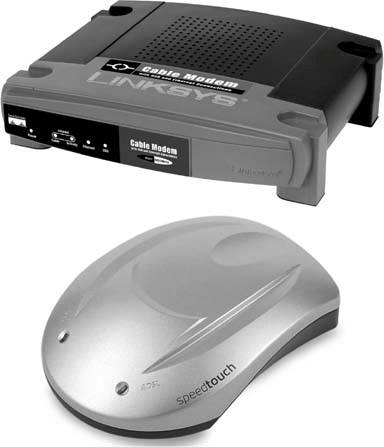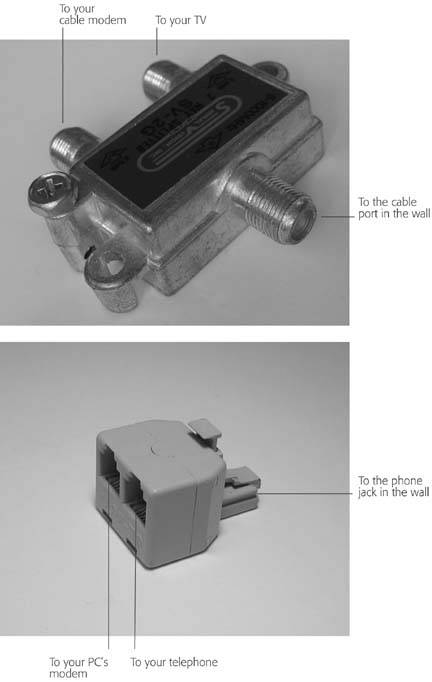11.2. Setting Up a Modem Before you can receive an Internet signal and all the goodies carried on it, your PC needs a working modem (short for MODulator-DEModulator). Modems come in two main flavors: dial-up and broadband. A dial-up modem converts your PC's data into sound waves and sends them through the phone lines to modems on the other end. The receiving modems convert the sound waves back into data, and the two hold some pretty boring conversations. Although some dial-up modems live in a little box on your desk, the vast majority are designed to live inside the PC, where their only visual identifier is a telephone jack (Section 1.8.4) or two on the back of your PC. A cable or DSL modem (also known as a broadband modem) sits in a little box near your computer (see Figure 11-2), where it separates the data from the TV or phone signals and passes the Internet signal onto your PC. Figure 11-2. Top: A cable modem is about the size of a small tissue box and sits anywhere near your PC. Although most cable companies give you one when you sign up, they usually charge a monthly rental fee. To save money, compare the rental fee to the cost of buying a cable modem from Linksys, Toshiba, or other manufacturers. (If you're thinking of connecting your PCs with a network, Linksys stuffs a cable modem, router/firewall (Section 15.7), and wireless access (Section 14.1.2) in one boxto create a space-saving, all in-one solution.) Before buying, check your cable company's support site and make sure the model's on their approved list.
Bottom: This DSL modem looks like a large mouse. You plug your phone cable into the box, and plug the box into your USB port to receive the Internet signal. 
11.2.1. Setting Up a Dial-Up Modem Almost all PCs sold today come with a built-in dial-up modem, usually a little silver strip on the back of your PC with two phone jacks (Section 1.8.4). Some PCs hide a phone jack near where your keyboard and mouse cables are plugged in. If you're stuck with a modemless PC, you can add a modem fairly easily by slipping a modem card into a card slot (Section 1.7.1) inside your PC. Setting up your PC's modem is as easy as plugging in a telephone. The secret is finding the correct modem port to use, since most modems have two ports. Look at the icons next to your modem's two telephone jacks to figure out which is which: -
Phone icon . Plug your telephone into the jack marked with this icon. Although not necessary, connecting a phone to your PC is a handy way to keep a phone close to your work area after your PC hogs the telephone jack. -
Jack icon . Connect a telephone cable between this jack and the phone jack in your wall. Laptops come with only one jack; that's the one that connects to the wall. Don't think you're wasting your phone jack if you choose broadband over dial-up service. Connect the modem to the wall jack, anyway. That lets Windows XP turn your PC into a makeshift fax machine, described in the online appendix, "Other Cool Things You Can Do Online," available on the "Missing CD" page at www.missingmanuals.com. 11.2.2. Setting Up a Cable or DSL Modem Many cable and DSL providers visit your home, install the equipment your PC needs, make sure everything works correctly, and then hand you the delivery papers to sign. But if your Internet Service Provider (ISP) offers a discount when you set up the equipment yourself, consider taking them up on it. Your ISP will send you a box-like modem, a network or USB cable, and an illustrated hook-up guide that explains the following three steps: -
Connect the TV cable to your cable modem, or connect the phone line to your DSL modem . -
Cable modem . On the back of this little box lives a coax cable port, just like the one on the back of your TV (Section 3.5.1). Connect a standard "cable TV" cable between the cable TV port in the wall and the identical port on your cable modem, tightly screwing down the connector with your fingers. (No need to reach for the pliers.) If a TV's hogging the cable TV port in the wall, you need a splitter, shown in Figure 11-3, which turns that one port into two: one for your TV and the other for your new cable modem. Most cable modems plug into an electrical outlet, as well. Figure 11-3. Splitters like these transform one cable or phone connection into two, perfect for sharing a cable TV or phone line with your PC. You can buy either of them for a few dollars at Radio Shack, most computer or stereo stores, and even drug stores.
Left: Screw your cable TV's cable into the single end of this connector. Then screw a cable onto each of the splitter's two other connectors; screwing one of the cables back into your TV and the other into your cable modem.
Right: Push this splitter into the phone jack in your wall to give you two phone jacks. Plug the DSL modem's phone cable into one jack; plug your telephone's cable into a filter, described below, and plug the filter into the splitter's other jack.  -
DSL modem . Connect a regular telephone cable from your telephone jack to this little box. If a phone's hogging your phone jack, buy a splitter, shown in Figure 11-3, at Radio Shack or most drug stores. It doubles your phone jack, giving you one jack for your phone and one for your DSL modem. Almost all DSL companies give you a handful of filters little two-inch-long gadgets with a phone jack on one end and a phone plug on the other. Unplug your main phone's cord from the wall jack, plug the cable into the filter, and plug the filter into the wall jack. Then repeat that procedure for all your phones, your answering machine, and anything else that plugs into the wall. Be sure to count your phones and answering machines so you know how many filters to request from the DSL company. Only the DSL modem itself can plug into an unfiltered line. -
Connect a network or USB cable between the modem and your PC's network or USB port . If you have a cable modem, take a look at Section 1.8.4, which shows a picture of the network cables you'll use (known as an Ethernet cables in tech-speak). DSL'ers: see Section 1.8.2.1, which shows a USB port and the connector you plug into it. -
Plug your modem into the wall's power outlet . Both cable and DSL modems usually need to plug into a power outlet. If those are scarce goods around your PC, it's time to buy a power strip. That's it. If your aging PC still doesn't have a network or USB 2.0 port, you need to add one (Section 1.7). When you run Windows' New Connection Wizard (Section 11.4.1), choose Broadband Connection. Windows XP figures out the details from there, fills out the right forms, and connects you to the Internet. Some broadband services supply a CD that does the same thing, as well as sprucing up Internet Explorer with the service's own logo.  |

